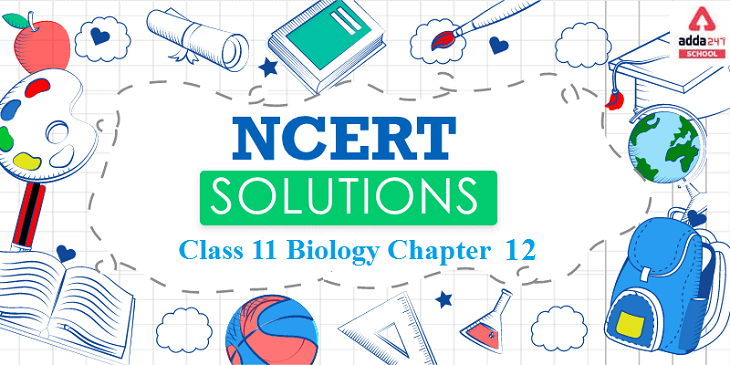Ncert Solutions For Class 11 Biology Chapter 12 in English
Class 11 Biology NCERT Solutions: Adda 247 provides NCERT Solutions for Class 11 Biology Chapter 12 which is for the students who want to go ahead in life and achieve great marks in their examinations. The NCERT Solutions for class 11 are provided by the teachers who are experts of their subjects. The solutions are set according to the rules formulated by the NCERT class 11 biology and in the language that can be understood by every student. By these reading, the solutions students can build up a strong base easily. The NCERT class 11 Biology solutions cover chapters 1 to 22 with the important questions and the answers in a detailed way.
Examinations can be threatening for some people, a proper learning of the concepts is the key to crack the examination. Students rely on the solutions of the NCERT provided by Adda 247. The solutions are formulated by the experts of the subjects who have tremendous knowledge in their subjects.
These NCERT Solutions of class 11 help the students to get familiarized with the textbooks. The students can access the solutions anywhere while browsing the web easily. The solutions are very precise and accurate.
NCERT Solutions for Class 11 Biology Chapter 12 – Mineral Nutrition
The chapter provides information about Mineral nutrition. Macronutrients (Macroelements or major elements): Nutrients which are required by plants in larger amounts (Generally present in the plant tissues in concentrations of 1 to 10 mg per gram of dry matter). Micronutrients (Microelements or minor elements or trace elements): Nutrients which are required by plants in very small amounts, i.e., in traces (equal to or less than 0.1 mg per gram dry matter).
[sso_enhancement_lead_form_manual title=”Download Full PDF of Class 11 Biology Chapter 12 ” button =”Download Now” pdf =”/jobs/wp-content/uploads/2021/06/17122548/English-chapter-12.pdf”]
Features of the NCERT Solutions for Class 11 Biology Chapter 12- Mineral Nutrition
NCERT Solutions for class 11 biology chapter 12 have been answered based on the important information on the question.
- The columns are used wherever necessary.
- Solutions are solved point-wise and accurately answered point to point.
Important Questions Ncert Solutions For Class 11 Biology Chapter 12- Mineral nutrition
Question 1. All elements that are present in a plant need not be essential to its survival’. Comment
Answer: Plants tend to absorb different kinds of nutrients from the soil but all of them are not required for there survival because they do not directly involved in the composition of their body. A nutrient is inessential for a plant if it is not directly involved in the plant’s physiology and metabolism. If the concentration of micronutrients such as Fe, Mn, Cu, Zn, Cl etc., rise above their critical values, they appear to be toxic for the plant.
Question 2. Why is purification of water and nutrient salts so important in studies involving mineral nutrition using hydroponics?
Answer: The technique of growing plants in soil-less conditions in solution cultures is called hydroponics. Hydroponic studies are used to identify the functions and roles of different mineral elements in the physiology of plants. While such studies, it is important to purify water and nutrient salts because if there are impurities in water and nutrient salts the exact physiological role and deficiency symptoms of elements could not be identified. Therefore, in studies involving mineral nutrition using hydroponics, purification of water and nutrient salts is essential so as to maintain an optimum growth of the plants.
Question 3. Explain with examples: macronutrients, micronutrients, beneficial nutrients, toxic elements and essential elements.
Answer:
(i)Macronutrients These are generally present in plant tissues in large amount (in excess 10 m mole of dry matter). The macronutrients include carbon, hydrogen, oxygen, nitrogen, phosphorus, sulphur, potassium, calcium and magnesium.
(ii) Macronutrients Micronutrients or trace elements, are needed in very small amount (less than 10m mole of dry matter). These include iron, manganese, copper, molybdenum, zinc, boron, chlorine and nickel.
(iii) Beneficial nutrients The elements which are not essential for plants, hut their presence are beneficial for the growth and development. Such, element are called beneficial elements.
(iv) Toxic elements Any mineral ion concentration in tissues, that reduces the dry weight of tissues by about 10% is considered toxic. For example, Mn inhibit the absorption of other elements.
(v) Essential elements The macronutrients including carbon, hydrogen, oxygen, nitrogen, phosphorus, sulphur, potassium, calcium and magnesium, which are required directly for the growth and metabolism of the plants and whose deficiency produces certain symptoms in the plants are known as essential elements.
Question 4. Name at least five different deficiency symptoms in plants. Describe them and correlate them with the concerned mineral deficiency.
Answer:
(a) Chlorosis: It is the yellowing of leaves due to the loss of chlorophyll. It due to the deficiency of Mn, N, K, Mg, S, Fe, Zn and Mo.
(b) Die back: It is the withering of stem from apex downward. It is due to the deficiency of copper.
(c) Necrosis: It is the death of the tissues. The leaf tips develop dead areas or necrotic areas. It may be also due to Ca, Mg, Ni, Cu and K
(d) Whiptail disease: It occurs in cauliflower. It is due to the deficiency of Mo.
(e) Little leaf disease: It is due to the deficiency of Zn. It also causes rosette of apple and peaches.
Question 5. If a plant shows a symptom which could develop due to deficiency of more than one nutrient, how would you find out experimentally, the real deficient mineral element?
Answer: In plants, the deficiency of a nutrient can cause multiple symptoms. For example, the deficiency of nitrogen causes chlorosis and delayed flowering.
In a similar way, the deficiency of a nutrient can cause the same symptom as that caused by the deficiency of another nutrient. For example, necrosis is caused by the deficiency of calcium, magnesium, copper, and potassium.
Another point to be considered is that different plants respond in different ways to the deficiency of the same nutrient.
Hence, to identify the nutrient deficient in a plant, all the symptoms developed in its different parts must be studied and compared with the available standard tables.
Question 6. Why is that in certain plants deficiency symptoms appear first in younger parts of the plant while in others they do so in mature organs?
Answer: For “elements that are actively mobilised within the plants and exported to young developing tissues, the deficiency symptoms tend to appear first in the older tissues. For example, the deficiency symptoms of nitrogen, potassium and magnesium are visible first in the senescent leaves. In the older leaves, biomolecules containing these elements are broken down, making these elements available for mobilising to younger leaves. The deficiency symptoms tend to appear first in the young tissues, whenever the elements are relatively immobile and are not transported out of the mature organs. For example, elements like sulphur and calcium are a part of the structural component of the cell and hence are. not easily released.
Question 7. How are the minerals absorbed by the plants?
Answer: The process of intake of nutrients from the soil is called absorption. Plants absorb minerals
from the soil through the roots by two ways. (a) Passive absorption and (b) Active absorption. (a)
Passive absorption. It is simple process of diffusion of ions from higher concentration to lower
concentration into root cells. (b) Active absorption. The uptake of minerals ions against concentration
gradient is called active absorption. Such a movement of ions is carried out with the expenditure of
energy (ATP). Carriers are involved in active mineral absorption. Carrier + ion → Carrier ion complex
→ Carrier ion enters inner space.
Question 8. What are the conditions necessary for fixation of atmospheric nitrogen by Rhizobium? What is their role in N2 -fixation?
Answer: Rhizobium is a symbiotic bacteria present in the root nodules of leguminous plants. The basic requirements for rhizobium to carry out nitrogen fixation are as follows:
(a) Presence of enzyme nitrogenase.
(b) Presence of leg haemoglobin.
(c) Non-haem iron protein, ferrodoxin as the electron carrier.
(d) Constant supply of ATP.
(e) Mg+2 ions as co factors.
Role of Rhizobium in N2 fixation:
Rhizobium contains the enzyme nitrogenase: a Mo-Fe protein which helps in the conversion of atmospheric free nitrogen to ammonia.
The reaction is as follows:
N2 + 8e–+ 8H+ + 16ATP→2NH3 + H2 + 16ADP + 16Pi
- Plant, in turn, deliveries bacteria with proteins, carbohydrates and enough oxygen so that they
do not disturb the fixation process.
- A plant protein – Leghaemoglobin assists in providing oxygen for respiration process while free oxygen concentration level is still low enough to not hinder the nitrogenase activity.
Question 9. What are the steps involved in formation of a root nodule? Answer: Root nodules are found in plants belonging to the family Fabaceae or Leguminosae.
They include leguminous plants like beans, peas, peanuts etc.
It is formed due to the symbiotic association between the leguminous plant and the host- specific bacteria called the rhizobium.
The steps involved in root nodule formation are-
1) Rhizobium bacteria divides to form colonies which surround the root hairs and epidermal cells of the plant.
2) The root hair gets curled and get invaded by the bacteria.
3) After the invasion, it forms an infection thread that carries the bacteria into the cortex of the root.
4) Later the bacteria gets modified into rod-shaped bacteria called bacteroids.
5) As a result, the cells in the cortex and pericycle undergo cell division, which forms the root nodules. 6) These root nodules get connected with the vascular tissues of the roots for nutrient exchange and help in nitrogen fixation.
Question 10. Which of the following statements are true? If false, correct them: (a) Boron deficiency leads to stout axis.
(b) Every mineral element that is present in a cell is needed by the cell.
(c) Nitrogen as a nutrient element is highly immobile in the plants.
(d) It is very easy to establish the essentiality of micronutrients because they are required only in trace quantities.
Answer:
(a) True
(b) All the mineral elements present in a cell are not needed by the cell. For example, plants growing near radioactive mining sites tend to accumulate large amounts of radioactive compounds. These compounds are not essential for plants.
(c) Nitrogen as a nutrient element is highly mobile in plants. It can be mobilised from the old and mature parts of a plant to its younger parts.
(d) True











 CBSE Admit Card 2026 for Private & R...
CBSE Admit Card 2026 for Private & R...
 AILET 2026 AIR 1: Check Full Toppers Lis...
AILET 2026 AIR 1: Check Full Toppers Lis...
 AILET Result 2026 OUT, How to Download S...
AILET Result 2026 OUT, How to Download S...






